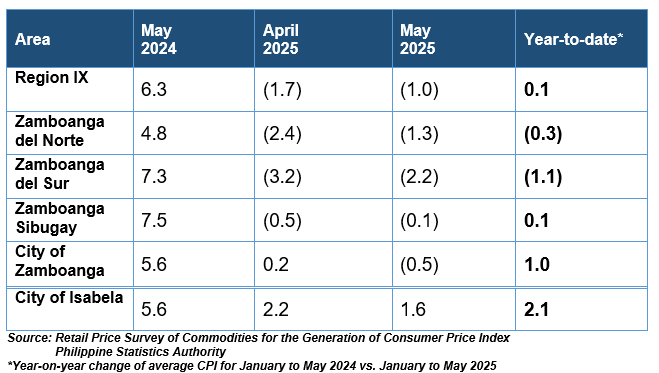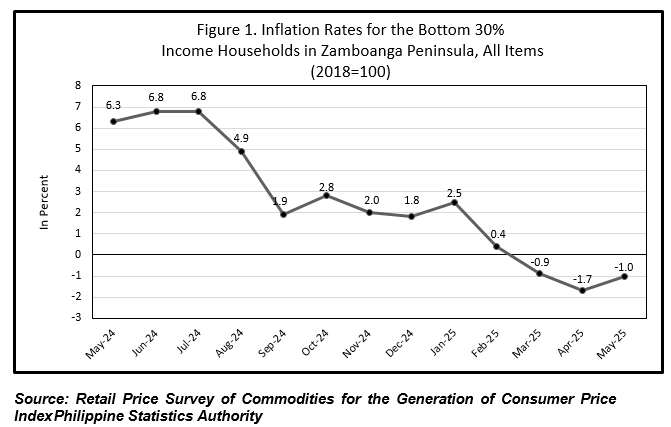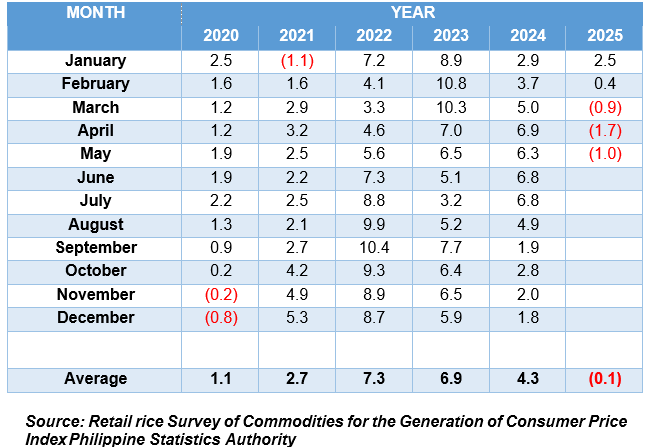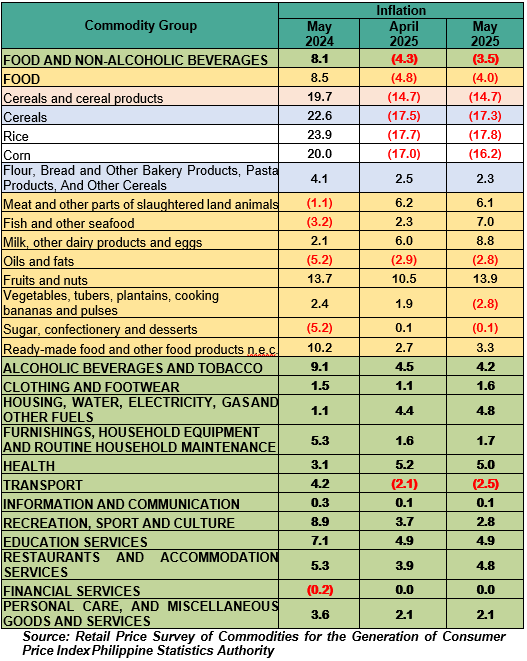Table A. Year-on-Year Inflation Rates,
for the Bottom 30% Income Household, All Items
In Percent
(2018=100)


A. Zamboanga Peninsula
1. Inflation Rate for the Bottom 30% Income Households
The inflation rate in Zamboanga Peninsula for the bottom 30% income households accelerated at a rate of (1.0) percent in May 2025 from (1.7) April 2025. This brings the region’s average inflation from January to April 2025 to (0.1) percent. In May 2024, inflation rate posted 6.3 percent. (Table A and Figure 1)
1.1 Main Drivers behind the Upward trend in the Inflation Rate for the Bottom 30% Income Households:
This month’s higher inflation rate was primarily influenced by the year-on-year inflation in the indices of Food and Non-alcoholic Beverages which stood at (3.5) percent inflation in May 2025 from (4.3) percent in April 2025, Housing, water, electricity, gas and other fuels at 4.8 percent from 4.4 percent in the previous month and Restaurants and Accommodation Services at 4.8 percent from 3.9 percent in the previous month.
Additionally, higher inflation rates were observed in the following commodity groups:
1) Clothing and footwear, 1.6 percent from 1.1 percent; and
2) Furnishings, household equipment and routine household maintenance, 1.7 percent from 1.6 percent.
In contrast, the following commodity groups posted lower annual increments as compared with their previous month’s inflation rates:
1) Alcoholic beverages and tobacco, 4.2 percent from 4.5 percent;
2) Health, 5.0 percent from 5.2 percent;
3) Transport, (2.5) percent from (2.1) percent; and
4) Recreation, sport and culture, 2.8 percent from 3.7 percent.
Moreover, the following commodity groups retained their inflation rates during the month:
1) Information and communication, 0.1 percent;
2) Education services, 4.9 percent;
3) Financial services, 0.0 percent; and
4) Personal care, and miscellaneous goods and services, 2.1 percent.
2.2 Main Contributors to the Inflation Rates for the Bottom 30% Income Households:
The following commodity groups were the top two contributors to the May 2025 overall inflation for the bottom 30% income households:
1) Food and Non-alcoholic Beverages, 202.4 percent share or (2.02) percentage point; and
2) Transport, 13.2 percent share or (0.13) percentage point.
Table B. Year-on-year Inflation Rates for the Bottom 30% Income Households
in Zamboanga Peninsula, All items in Percent
January 2020- May
(2018=100)

Inflation Rate by Commodity Group for the Bottom 30% Income Households in
ZAMBOANGA PENINSULA 2018=100

Food Inflation
The Food inflation for the bottom 30% Income Households in Zamboanga Peninsula accelerated to (4.0) percent in May 2025 from (4.8) percent in April 2025. Meanwhile, the food inflation in May 2024 was higher at 8.5 percent.
2.1 Main Drivers to the Upward Trend of the Food Inflation for the Bottom 30% Income Households
The acceleration in the food inflation was mainly due to the higher increase in the indices of Fish and other seafood (ND) which posted 7.0 percent from 2.3 percent. Moreover, the categories of Milk, other dairy products and eggs (ND) and Fruits and nuts (ND) also contributed to the uptrend which stood at 8.8 percent from 6.0 percent, and 13.9 percent from 10.5 percent, respectively.
In addition, the following food groups were observed to have higher increments during the month:
1) Oils and fats, (2.8) percent from (2.9) percent;
2) Ready-made food and other food products n.e.c. (ND), 3.3 percent from 2.7 percent; and
3) Corn, (16.2) percent from (17.0) percent.
In contrast, the following food groups were observed to have decelerated during the month:
1) Rice, (17.8) percent from (17.7) percent;
2) Flour, Bread and Other Bakery Products, Pasta Products, and Other Cereals. 2.3 percent from 2.5 percent;
3) Meat and other parts of slaughtered land animals (ND), 6.1 percent from 6.2 percent;
4) Vegetables, tubers, plantains, cooking bananas and pulses (ND), (2.8) percent from 1.9 percent; and
5) Sugar, confectionery and desserts (ND), (0.1) percent from 0.1 percent.
Cereal and cereal products retained its previous month’s inflation with (14.7) percent.
2.2 Main Contributors to the Food Inflation for the Bottom 30% Income Households:
Food Inflation contributed 219.5 percent share or (2.20) percentage points to the May 2025 for the Bottom 30% Income Households. Among the food groups, the main contributors to the food inflation during the month were the following:
1) Cereals and cereal products, 168.3 percent share or (6.73) percentage points;
2) Vegetables, tubers, plantains, cooking bananas and pulses (ND), 6.2 percent share or (0.25) percentage point; and
3) Oils and fats (ND), 0.8 percent share or (0.03) percentage point.
Among the provinces in the region, City of Isabela had the highest inflation for the bottom 30% income households with 1.6 percent inflation, followed by Zamboanga Sibugay with (0.1) percent, followed by City of Zamboanga at (0.5) percent, then Zamboanga del Norte with (1.3) percent. Zamboanga del Sur recorded to have the lowest inflation rate at (2.2) percent.
Note: CPIs and inflation rates for the bottom 30% income households by region and by province and selected city are posted at the PSA website (http://openstat.psa.gov.ph/).
MEWCHUN WS. PAMARAN
Regional Director
GBS/MGCN/ajdc
